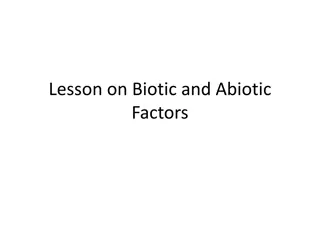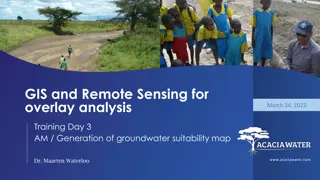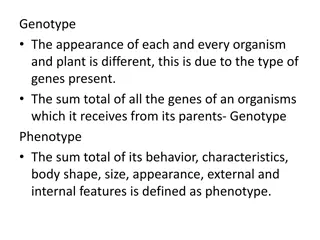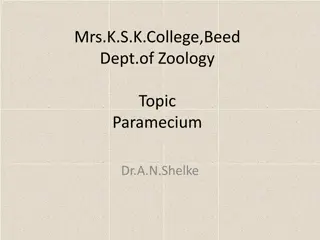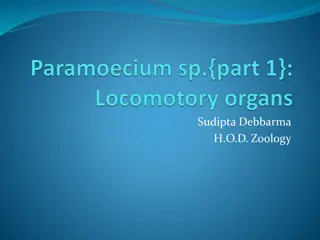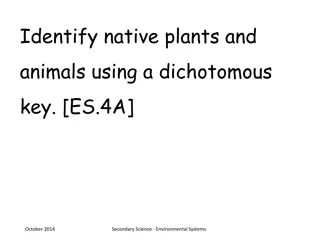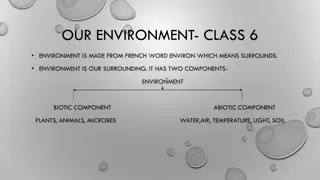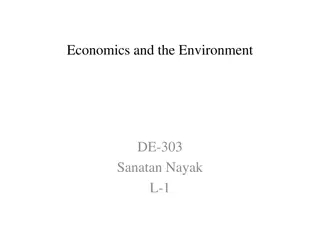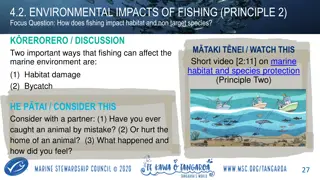Understanding Organism Habitat Suitability Through Abiotic Factors
Explore the relationship between organisms and their habitats based on abiotic factors like pH, temperature, light intensity, and more. Learn how to measure and relate these factors to the organisms' choice of habitat, with practical investigation procedures and result analysis provided.
Download Presentation

Please find below an Image/Link to download the presentation.
The content on the website is provided AS IS for your information and personal use only. It may not be sold, licensed, or shared on other websites without obtaining consent from the author. Download presentation by click this link. If you encounter any issues during the download, it is possible that the publisher has removed the file from their server.
E N D
Presentation Transcript
Choice of Habitat Relationship between an organism s suitability to its habitat and abiotic factors to include measurement of any three of the following: pH Temperature (air and ground or aquatic) Light intensity Water current Air current Dissolved oxygen Mineral content Percentage air in soil Percentage water in soil Percentage humus Salinity Degree of exposure Slope 1
1.5.4 INVESTIGATE ANY THREE ABIOTIC FACTORS PRESENT IN THE SELECTED ECOSYSTEM, AS LISTED RELATE RESULTS TO CHOICE OF HABITAT SELECTED BY EACH ORGANISM IDENTIFIED IN THIS STUDY Abiotic factors as listed in the syllabus: pH, temperature (air and ground or aquatic), light intensity, water current, air current, dissolved oxygen, mineral content, percentage air in soil, percentage water in soil, percentage humus, salinity, degree of exposure and slope. Materials/Equipment Equipment to measure the chosen abiotic factors. 2
From Syllabus Clarifications 1.5.4 Keep it simple presence or absence of the abiotic factor will suffice. Measure simply e.g. temperature. Relate the abiotic factor to the ecosystem being studied. Three (3) suitable factors that are relevant /present in the habitat from the list above. Investigate these factors in the investigation. Suitability to habitat. (Syllabus P13, Teacher Guidelines P23). 3
Procedure 1. Choose any three abiotic factors present in the selected ecosystem from the list above. Measure the abiotic factors for the habitat of each of the identified organisms by using the appropriate equipment and following the relevant instructions. Record results. Familiarise yourself with all procedures before starting. Relate results to the choice of habitat by commenting on the suitability of each habitat for the organism. 2. 3. 4. 5. 4
Result Abiotic factors and measurements Organism Name Habitat 5
Click on the link for background information on: pH temperature (air and ground or aquatic) light intensity water current air current dissolved oxygen mineral content % air in soil % water in soil % humus in soil salinity degree of exposure slope Advance preparation Helpful hints 7
pH Both in soil and water, pH affects plant growth. Each species grows best at a certain pH. Any departure from the optimum pH will have an adverse effect and may kill the plant. Plants such as bracken, gorse, heather, azalea, rhododendron, camellia, and oak only grow on acid soils (pH range 4.0 - 6.5). These plants are now known to be intolerant of calcium ions in the soil and may be known as calcifuges ( lime haters ). Plants that live in limestone soils (pH range 7.5 - 9.0) are known as calcicoles ( limetolerant ) 8
pH Certain aquatic animals, such as the freshwater shrimp, can tolerate a wide range of pH. Others, such as planarian flatworms, caddis fly larvae and some damselfly nymphs are more abundant in alkaline, calcium-rich waters. Earthworms also prefer alkaline soils. Marked changes in pH are ecological features in some areas e.g. woodland in Killarney National Park. The pH over the limestone areas is alkaline and one finds beech and ash. As the soil becomes acidic over the sandstone areas the flora changes and oak becomes the predominant tree species. 9
pH Within certain habitats there can also be marked changes in pH. Heathland fires significantly alter the surface pH by adding ash from the burnt stems and leaves of heather and other plants. Ash is extremely alkaline, at pH 10.0 - 11.5. The pH in the soil changes rapidly from 4.5 to about 9.0. For a few weeks after the fire pH falls slowly as alkaline salts are leached from the soil, stabilising at about 5.0 after eight weeks or so. It is thought that the high pH inhibits the germination of heather seeds until the acidic conditions are established. 10
Back to Select from Abiotic List Measuring pH: The pH of water samples can be measured directly using pH paper or a pH meter and a probe. To measure the pH of soil, take a sample of soil, place it in a measuring cylinder and add an equal volume of distilled water. Shake vigorously for about 10 minutes and then filter. (If clay particles are present, they can be flocculated by using barium sulphate solution instead of distilled water.) The pH of the filtrate is then measured. 11
Temperature (air and ground or aquatic) Throughout northern Europe there is a seasonal variation in temperature closely linked to light intensity. There are also daily temperature and light cycles. In ecological studies, the precise temperature at any one moment is of little value. Of much greater significance are the diurnal (daily) and seasonal variations. Diurnal temperature is best measured with a max-min thermometer. 12
Temperature (air and ground or aquatic) Temperatures at different heights of vegetation above ground level are also of considerable practical importance. Investigations have shown that at midday the foliage, together with the bare soil between plants, are the warmest places. At night the bare soil cools more rapidly. Therefore if vegetation is removed ground level temperature shows marked fluctuations, a factor that affects the rate of recolonisation. 13
Temperature (air and ground or aquatic) Most plants photosynthesise between April and September, when the mean air temperature is above 8 oC. For the rest of the year they undergo changes that assist survival at low temperatures. Annual plants produce cold-resistant seeds, perennials shed their leaves and form buds or dormant underground storage organs. 14
Temperature (air and ground or aquatic) The winter survival tactics shown by animals include cold avoidance and cold tolerance. Cold avoidance is shown by migratory birds and butterflies, whose annual migration to warmer climates ensure they never experience adverse weather conditions. Cold tolerance is shown by insects - many insects enter a non-feeding stage to overwinter. Hedgehogs hibernate for the winter. Temperature gradients are an important feature of ponds and lakes especially in summer. Such a gradient exists because warm water rises to the surface and cold water falls. 15
Back to Select from Abiotic List Measuring Temperature: Temperature can be measured using a standard mercury-in glass or alcohol thermometer. Such a thermometer with a thickened bulb and in a protective case can be used in air, soil and water. Digital thermometers could be used to measure habitat temperatures instead of standard thermometers. Standard max/min thermometers can be used to measure the temperature range over a period of time which, for many investigations, is more important than a reading at any particular moment. 16
Light intensity Sunlight is the source of energy that drives all ecosystems. Seasonal variation in light intensity affects plant productivity. Less than 0.25% of the total incident radiation on the earth is used by plants in the process of photosynthesis. Many plants grow in direct sunlight, but most plants show some degree of shade tolerance. Animals respond to changes in light intensity by modifying their behaviour, often moving away from or towards light. 17
Light intensity Two aspects of light, its duration and its intensity, are generally important to ecological studies. The duration of daylight hours can be determined astronomically and is predictable for any location. Photoperiodism is a biological response to the changes in the ratio of light and dark in a 24 - hour period. Flowering plants may be divided into three categories: 18
Light intensity a) Short day plants. These plants flower in early spring or autumn and require a dark period exceeding a certain critical length. b) Long day plants. These plants require a period less than the critical period. They flower in summer. c) Day-neutral plants. These plants are unaffected by photoperiod. Some plants require only a single exposure to the critical day-night cycle in order to flower. 19
Light intensity Examples of photoperiodic responses in animals are a) Many small birds and mammals mate in spring and early summer due to increasing daylight. b) Conversely, sheep and goats respond to shortening day length as they mate in late summer/early autumn. 20
Measuring light intensity: Light intensity can be measured at any particular time using light meters, such as those used by photographers. However, the readings may not be very useful because light levels fluctuate continuously. In addition, if light intensity is being studied in relation to the distribution of plants, it is more important to measure the light received over a relatively long period of time, because it is this which most affects plant performance. 21
Back to Select from Abiotic List Measuring light intensity: Light probes connected to a computer or data- logger can be used to take continuous measurements of light. Alternatively, it is possible to compare the amount of light received over a long period of time by using lightsensitive paper, such as ozalid paper used by printers. This gradually darkens on exposure. 22
Water current A still body of water will inevitably be disturbed by various factors, which will affect the distribution of organisms in the water. Wind is considered to be the prime factor responsible for disturbing water, though changes in temperature can create convection currents where temperature is evened out across the body of water via this movement. 23
Water current Still water communities can vary greatly in appearance, anything from a small temporary puddle to a large lake is capable of supporting life to some extent. The size and depth of a still body of water are major factors in determining the characteristics of that ecosystem. 24
Water current One of the main differences between still water and running water communities is the fact that the water is moving at a particular velocity in running water communities. This can have great bearing on what organisms occupy the ecosystem and what particular ecological niches they can exist in. Running water can bring many factors into play affecting the lives of the organisms in this particular environment: 25
Water current Movement of minerals and stones caused by the velocity and volume of the water means the water bed is constantly changing. The faster and higher volume of water present will result in a direct increase in amount and size of particles shifted downstream. Standing waves are used by salmon at the bottom of waterfalls to spur them upstream. At the same time, they cause small air pockets, which results in a small habitat becoming available suited to particular organisms. 26
Water current Erosion is caused by the running water breaking down the river bank and beds, causing the geography of the river to change over a long period of time. This means, for example, that hydroseres previously occupying the river bank may find themselves distanced from the running water and over time this would mean the overall ecosystem would change. 27
Water current In general the diversity of plant species in a running water community is small compared to that of a still water community. Most plants have gone through evolutionary adaptations to cope with the force and different conditions that running water brings. As these conditions are more harsh for a typical species of plant, more notably larger plants, smaller species have found the conditions of the community more favourable. This is due to the fact that they are more flexible in regards to the physical conditions of the water. Algae can grow in all sorts of different places and surfaces, and therefore are a successful constituent of the running water ecosystem. 28
Water current Most of these algae have developed evolutionary adaptations over time that prevent the water current sweeping them away. Other animals have developed some of the following adaptations over time that help them cope with the conditions in hand: 29
Water current Suckers These suckers attach themselves to a surface and can also assist movement in any direction. Hooks/Claws These sharp objects can dig into any given object and allow the animal to cling to a position or claw their way around the surface. Body flattening This adaptation can allow the animal in the water bear less of the brunt of the force of water moving downstream, therefore reducing it as an inhibitor of their movement. This also allows these animals to enter confined areas (such as under stones) that may present a useful environment for them to live in. 30
Water current Streamlining This reduces the frictional forces between the flowing water and the streamlined animal. Flight Some animals have adaptations allowing them to fly, removing themselves from the force of the current at ground level and enabling them to move upstream more easily if needs be. 31
Back to Select from Abiotic List Water current The simplest procedure to measure water current is to record the time taken for a floating object to travel a known distance. It is preferable to use an object which is mainly submerged to eliminate any wind effects. Formula: Current (m/sec) = distance travelled by the object time taken to travel that distance 32
Air current Air movements may affect organisms indirectly, by evaporative cooling or by a change in humidity. It may also affect them by determining their shape; the development of branches and roots of trees in exposed areas. Wind is important for dispersal of seeds and spores. When considering wind speed and direction, it is important to remember that for most ecological studies, degree of exposure is more important than wind speed at any one time. Degree of exposure is a function of wind frequency, speed, and direction. 33
Back to Select from Abiotic List Measuring air current: A wind vane measures direction and an anemometer measures wind speed. 34
Dissolved oxygen Oxygen concentration in water is a limiting factor for most aquatic organisms. Water always contains much less oxygen than atmospheric air e.g. at 0oC water contains approximately 10 cm3 /l dissolved oxygen. As the temperature rises, the concentration of dissolved oxygen falls and at 30oC the level of dissolved oxygen is about 5 cm3/l. An animal s requirement for oxygen increases as the temperature rises and it is not difficult to see why aquatic animals may experience stress during hot weather. 35
Dissolved oxygen Oxygen gradients exist in large ponds and lakes most of the year. Surface water, 100% saturated, may contrast greatly with the water at the bottom of the pond, which may be only 25% saturated. 36
Dissolved oxygen Oxygen depletion may occur for any of the following reasons a) In winter when the water is covered with ice. b) In late summer when plants die back and microorganisms decompose dead leaves. c) At any time if sewage or other organic effluents enter the water. 37
Back to Select from Abiotic List Measuring dissolved oxygen: a dissolved oxygen probe and meter or the Winkler method may be used to measure dissolved oxygen. 38
Mineral content Inorganic ions constitute approximately 1% of an organism by weight, but they are essential for its health. When a mineral is in short supply or missing the organism develops deficiency symptoms. 39
Back to Select from Abiotic List Mineral content Soil is tested by farmers and gardeners for the presence or absence of certain essential minerals, using soil test kits. Kits are available from garden centres. Minerals in soil become used up or leached away and may have to be replaced using fertilisers or by leaving the ground fallow for a season. Different plant species have different mineral requirements and the distribution therefore depends on the mineral balance of a particular soil. 40
Back to Select from Abiotic List Percentage air in soil The amount of air present in the soil depends on the structure of the soil and its water content. Waterlogged soils contain little oxygen. Low oxygen levels can cause anaerobic bacteria to thrive e.g. sulphur bacteria, which produce hydrogen sulphide (a gas toxic to many plants). Oxygen is needed by plants for the uptake of minerals by active transport from the soil. 41
Back to Select from Abiotic List Percentage water in soil The water content of soils varies greatly. Any freely drained soil, which holds as much water as possible is said to be at field capacity. Addition of any more water which cannot drain away causes water logging and anaerobic conditions. Some plants can tolerate waterlogged conditions. Many headed bog- cotton which inhabits bog pools has aerenchyma tissue which channels oxygen to the roots of the plant which allows it to penetrate to depths of 60cm into the waterlogged peat. Yarrow, which lives in drier soil, is a hemi parasite which lives off minerals and water from roots of other plants. 42
Percentage humus A major component of soil is dead organic matter e.g. leaf litter. As it decomposes it forms a gelatinous brown-black material called humus. Humus is a colloidal acid substance, an immediate product in the decomposition of dead plants and animals. The presence of humus encourages plant growth for a number of reasons. 43
Back to Select from Abiotic List Percentage humus 1. The moist sticky substance binds minerals together forming a crumbly, less compacted soil. This increases the air content of the soil and improves drainage. Humus provides food for many invertebrates e.g. earthworms. Humus and clay particles carry negative charges, which prevent positively charged ions from being washed out of the soil by rain (leaching). Humus absorbs solar radiation because of its dark colour. Humus rich soils heat up quickly, promoting the germination of seeds and the growth of seedlings. 2. 3. 4. 44
Salinity The salt content (salinity) of a water body is one of the main factors determining what organisms will be found there. Thus fresh waters and saline waters are inhabited by quite different organisms. Plants and animals that live in or use freshwater generally have a salt content inside their cells that is greater than the water they inhabit or use. They tend to give off salts as waste products. Saltwater plants and animals have a salt content equal to or less than the salinity of the surrounding water, and thus have different mechanisms for maintaining their salt balance. In brackish waters we find plants and animals that can tolerate changes in salinity. 45
Salinity Intertidal organisms tolerate abrupt changes in salinity. When the tide is out, they may be soaked in fresh water from rain, when the tide returns, they quickly return to a saltwater environment. Water in tide pools may evaporate, concentrating the salts and increasing the salinity. Organisms adapt to changes in salinity in two ways. They retain sea-water inside their shell (mussels), or quickly adjust their internal salt balance (tide pool fishes). 46
Back to Select from Abiotic List To measure salinity: Salinity can be measured using a conductivity probe and meter. Alternatively, since the density of water is related to the amount of salt dissolved in it, the salinity of the water can be determined from the density and water temperature. A hydrometer can be used to measure density. Using density and water temperature values the salinity can be read from a salinity table. 47
Degree of exposure (a) Air When the tide is out, intertidal organisms are exposed to the air. They must not dry out, and they must withstand air temperatures, which vary from hot in summer to bitter cold in winter. The intertidal area can be divided into zones, based on the length of time of exposure to air. Zones often are identified by the plants and animals that live within them. 48
Degree of exposure The splash zone is exposed to ocean spray, but is covered completely only during the highest of high tides. The plants and animals e.g. lichens, snails, sand hoppers that live here cannot live submerged in sea water but may benefit from salt water spray. The upper shore is out of the water most of the time; it is completely covered only during high tides. Plants and animals e.g. barnacles, snails, spiral wrack and channel wrack that can withstand much exposure to air live here. 49
Degree of exposure The mid shore is exposed to the air twice a day and it supports a great variety of plants and animals e.g. bladder wrack, knotted wrack, sea anemones, limpets. The lower shore is exposed to air only during the lowest tides. The plant and animal life e.g. sea urchins, starfish, and serrated wrack found here is abundant and varied. 50


